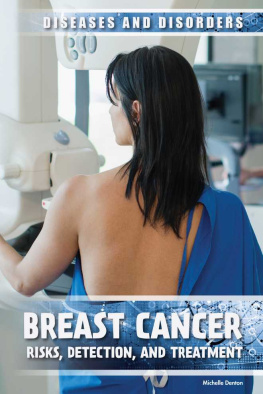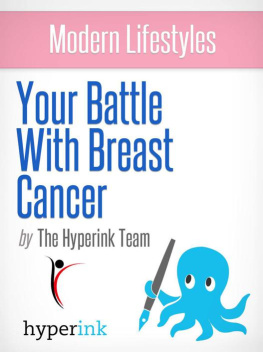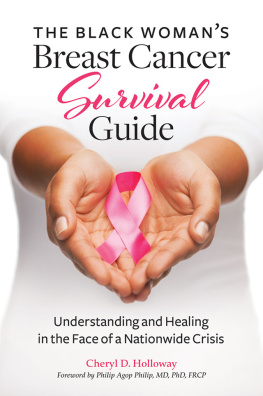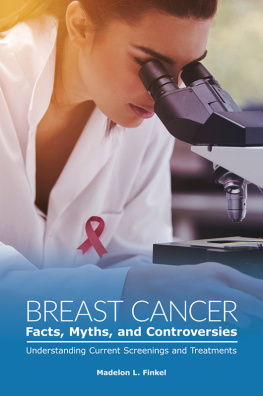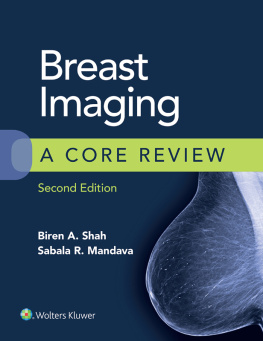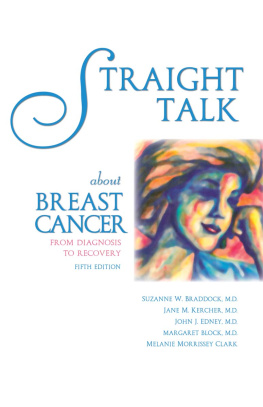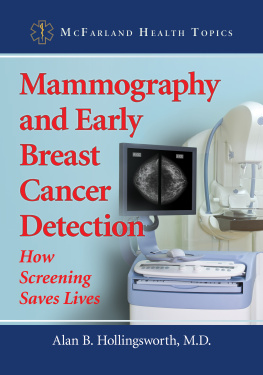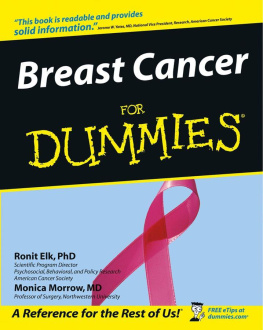Published in 2018 by
Lucent Press, an Imprint of Greenhaven Publishing LLC
353 3rd Avenue Suite 255
New York, NY 10010
Copyright 2018 Greenhaven Press, a part of Gale, Cengage Learning
Gale and Greenhaven Press are registered trademarks used herein under license.
All new materials copyright 2018 Lucent Press, an Imprint of Greenhaven Publishing LLC.
All rights reserved. No part of this book may be reproduced in any form without permission in writing from the publisher, except by a reviewer.
Designer: Deanna Paternostro Editor: Jennifer Lombardo
Cataloging-in-Publication Data
Names: Denton, Michelle.
Title: Breast cancer: risks, detection, and treatment / Michelle Denton.
Description: New York : Lucent Press, 2018. | Series: Diseases and Disorders | Includes index.
Identifiers: ISBN 9781534562837 (pbk.) | ISBN 9781534561915 (library bound) | ISBN 9781534561908 (ebook)
Subjects: LCSH: Breast-Cancer-Juvenile literature. | Breast-Cancer-Prevention-Juvenile literature.
Classification: LCC RC280.B8 D46 2018 | DDC 616.99'449-dc23
Printed in the United States of America
CPSIA compliance information: Batch #CW18KL: For further information contact Greenhaven Publishing LLC, New York, New York at 1-844-317-7404.
Please visit our website, www.greenhavenpublishing.com . For a free color catalog of all our high-quality books, call toll free 1-844-317-7404 or fax 1-844-317-7405.
Struggling and Surviving Together
Breast Cancer 101
Detecting and Diagnosing
Fighting the Good Fight
Surviving Breast Cancer
For the Future
I llness is an unfortunate part of life, and it is one that is often misunderstood. Thanks to advances in science and technology, people have been aware for many years that diseases such as the flu, pneumonia, and chicken pox are caused by viruses and bacteria. These diseases all cause physical symptoms that people can see and understand, and many people have dealt with these diseases themselves. However, sometimes diseases that were previously unknown in most of the world turn into epidemics and spread across the globe. Without an awareness of the method by which these diseases are spreadthrough the air, through human waste or fluids, through sexual contact, or by some other methodpeople cannot take the proper precautions to prevent further contamination. Panic often accompanies epidemics as a result of this lack of knowledge.
Knowledge is power in the case of mental disorders, as well. Mental disorders are just as common as physical disorders, but due to a lack of awareness among the general public, they are often stigmatized. Scientists have studied them for years and have found that they are generally caused by hormonal imbalances in the brain, but they have not yet determined with certainty what causes those imbalances or how to fix them. Because even mild mental illness is stigmatized in Western society, many people prefer not to talk about it.
Chronic pain disorders are also not well under-stoodeven by researchersand do not yet have foolproof treatments. People who have a mental disorder or a disease or disorder that causes them to feel chronic pain can be the target of uninformed opinions. People who do not have these disorders sometimes struggle to understand how difficult it can be to deal with the symptoms. These disorders are often termed invisible illnesses because no one can see the symptoms; this leads many people to doubt that they exist or are serious problems. Additionally, people who have an undiagnosed disorder may understand that they are experiencing the world in a different way than their peers, but they have no one to turn to for answers.
Misinformation about all kinds of ailments is often spread through personal anecdotes, social media, and even news sources. This series aims to present accurate information about both physical and mental conditions so young adults will have a better understanding of them. Each volume discusses the symptoms of a particular disease or disorder, ways it is currently being treated, and the research that is being done to understand it further. Advice for people who may be suffering from a disorder is included, as well as information for their loved ones about how best to support them.
With fully cited quotes, a list of recommended books and websites for further research, and informational charts, this series provides young adults with a factual introduction to common illnesses. By learning more about these ailments, they will be better able to prevent the spread of contagious diseases, show compassion to people who are dealing with invisible illnesses, and take charge of their own health.
INTRODUCTION
S amantha first noticed the lump in her breast while sitting on the couch at her sisters birthday party. At 29 years old, she assumed it was a harmless cyst, a common occurrence in women as they head into their 30s. Nevertheless, she contacted her doctor to have it examined. After test results came back unclear, she went to a general surgeon to have the lump removed, and that was when everything changed. That day at work, I received a call from the surgeon asking me to call him and saying I should have him paged if he wasnt available, Samantha wrote. The message alarmed me and I knew something wasnt right. Over the phone, he told me that the lump hed removed was malignant. I had to clarify what he meant: Was it cancer? When he said the words, Im so sorry, I knew it was cancer. Samanthas case, however, was relatively unusual. Although breast cancer is the most commonly diagnosed cancer in women in the United States, most breast cancers occur in women over the age of 50.
Breast cancer can affect people of any sex and race. The National Cancer Institute estimated that by the end of 2017, approximately 252,710 cases of breast cancer would be diagnosed in women in the United States and that more than 40,000 of them would die from it. The institute also estimated that more than 2,470 men would develop breast cancer, with about 460 deaths. White women are the most likely to get breast cancer, but black women have the highest death rates after diagnosis, possibly because of genetic differences in the tumors, socioeconomic barriers to getting effective health care, or getting diagnosed at a later stage of the disease. Women who are of Ashkenazi Jewish descent have a higher risk of breast cancer because they tend to carry and pass on a specific genetic mutation that increases breast cancer risk. Hispanic, Asian, and Native American women have the lowest incidence and death rate when it comes to breast cancer, and these occurrences are slowly decreasing.

The overall incidence of breast cancer has been declining since 2000, and death rates from the disease have been decreasing since 1989. Thanks to a greatly improved understanding of the nature of breast cancer and improved treatment methods, the survival rate for some types of breast cancer is nearly 100 percent, especially if it is detected early.

